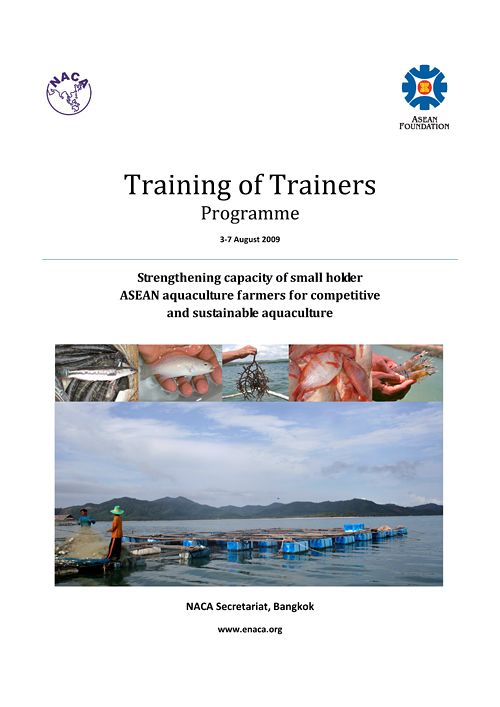Training of Trainers: Strengthening capacity of small holder ASEAN aquaculture farmers
31 March 2010 | 1307 Downloads | .pdf | 2.85 MB | Better management practices, Cambodia, Freshwater finfish, Indonesia, Inland aquaculture, Aquatic plants, Marine finfish, Philippines, Shrimp, Environment and Sustainability, Thailand, Education and Training, Vietnam
In ASEAN countries, aquaculture is an important activity and several thousands of small farmers are engaged in this activity to earn their livelihood. Fish being a major animal protein source in ASEAN countries, greater importance is attached to ensure good quality safe fish and its products availability to all sections of the population. ASEAN Foundation plays critical role in ensuring development of all its members through cooperation.
This project entitled “Strengthening the capacity of small holder ASEAN farmers for competitive and sustainable aquaculture” has been supported by the foundation to accomplish the ASEAN vision of 2020. The project objectives are to improve the competitiveness of ASEAN aquaculture small holders in the domestic, regional and global markets, to improve sustainability of their farming systems, to make them adopt responsible farming practices and improve their profitability.
Five ASEAN countries, namely, Cambodia, Indonesia, Philippines, Thailand and Vietnam were chosen as the representative countries. Based on the interest expressed by each country and the inception workshop that was held as part of the project activities, following five commodities were chosen:
(a) In Cambodia, snakeheads contribute to the food and economy of people immensely and they were cultured in cages and ponds for several decades. In 2005, Cambodia banned the culture of this species as farmers were using seeds collected from the wild and fed them with fresh fish caught from wild. In order to develop better feed management practices and explore the culture of snakeheads using other feed resources, Cambodia chose snakeheads as the commodity for research under the project.
(b) Tilapia being the most rapidly growing and widely cultured commodity, Thailand decided to work with farmers engaged in farming of tilapia in cages as well as ponds.
(c) Sea weed cultivation has contributed immensely in providing livelihoods to several farmers in Philippines. However, with the increasing quality requirements in the international markets, farmers are facing many challenges with the declining environmental qualities that are contributing for the increasing crop failures and declined profitability. To address these problems, Philippines decided to work with farmers engaged in sea weed farming.
(d) Indonesia has made good progress in breeding of groupers and sea bass and several small farmers are engaged in culturing these species both for local as well as export market. As the livelihood of several farmers is dependent on these species culture, Indonesia preferred to work on groupers and sea bass as the commodities.
(e) Vietnam has demonstrated its entrepreneurial approach in developing market for various aquatic products. Shrimp farming is widely practiced in the country, but like in many other countries, the activity has been affected by the disease problems. Hence, Vietnam chose to work with shrimp.
The training of trainer session was organized to build the capacity of national project partners who in turn would train the farmers locally using the acquired knowledge. Based on the needs assessment carried out on each commodity, the training program was designed taking in to consideration of the needs as well as the overall goal of the project. The training program included technical aspects related to the culture of commodities, marketing, access to information, organization of farmer groups, mainstreaming of gender, coping strategies with various environmental changes and ways to reduce negative impact by adopting good culture practices.
The training program was attended by seventeen participants from five countries and they were trained by sixteen experts drawn from various organizations. Participants had an opportunity to discuss the lecture in the context of their country situation and the commodities they have targeted. Each of the countries also presented the needs assessment carried out and based on that participants were given additional support needed to design their own training programs. They were also given an opportunity to visit the Asian Institute of Technology and gain knowledge about the activities carried in developing tilapia breeding and culture technology to meet the market necessities.
In this volume, lectures presented by experts are included in unedited form for usage. At the end of the project, these lectures along with the training needs assessment reports, training manuals developed and the lessons learnt would be compiled together for wider dissemination. For any additional information on the lectures, please contact them directly using the e-mail address provided.
Creative Commons Attribution.

